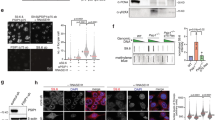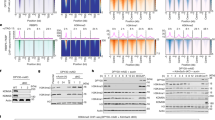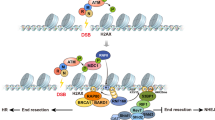Abstract
Little is known of the specific biochemical mechanism by which heterochromatin protein 1 (HP1) inactivates a gene. We analyzed HP1-mediated inhibition of preinitiation complex (PIC) assembly in vitro on chromatin templates regulated by GAL4-VP16 or Sp1. HP1 blocked key subunits of the TFIID and Mediator coactivator complexes. Notably, binding of the same subunits was inhibited by HP1 on the Sp1-regulated survivin gene in vivo upon DNA damage–induced silencing.
This is a preview of subscription content, access via your institution
Access options
Subscribe to this journal
Receive 12 print issues and online access
$189.00 per year
only $15.75 per issue
Buy this article
- Purchase on Springer Link
- Instant access to full article PDF
Prices may be subject to local taxes which are calculated during checkout



Similar content being viewed by others
References
Maison, C. & Almouzni, G. Nat. Rev. Mol. Cell Biol. 5, 296–304 (2004).
Smallwood, A., Esteve, P.O., Pradhan, S. & Carey, M. Genes Dev. 21, 1169–1178 (2007).
Loyola, A., LeRoy, G., Wang, Y.H. & Reinberg, D. Genes Dev. 15, 2837–2851 (2001).
Conaway, J.W. et al. FEBS Lett. 579, 904–908 (2005).
Wright, K.J., Marr, M.T., II & Tjian, R. Proc. Natl. Acad. Sci. USA 103, 12347–12352 (2006).
Vassallo, M.F. & Tanese, N. Proc. Natl. Acad. Sci. USA 99, 5919–5924 (2002).
Johnson, K.M., Wang, J., Smallwood, A., Arayata, C. & Carey, M. Genes Dev. 16, 1852–1863 (2002).
Chen, L. & Widom, J. Cell 120, 37–48 (2005).
Dellino, G.I. et al. Mol. Cell 13, 887–893 (2004).
Hatzis, P. & Talianidis, I. Mol. Cell 10, 1467–1477 (2002).
Yudkovsky, N., Ranish, J.A. & Hahn, S. Nature 408, 225–229 (2000).
Kim, T.H. et al. Nature 436, 876–880 (2005).
Acknowledgements
This study was supported by a grant from the US National Institutes of Health to M.C. (GM074701). J.C.B. was supported by a Ruth L. Kirschstein National Research Award (GM07185). We thank S. Smale (University of California, Los Angeles) for HP1 antibodies, and J. Conaway and R. Conaway (Stowers Institute for Medical Research, Kansas City, Missouri, USA) for the MED4 antibody.
Author information
Authors and Affiliations
Contributions
A.S. and J.C.B. designed and performed the experiments and prepared the manuscript; N.T. and S.P. contributed reagents and assisted with experimental design; M.C. designed experiments, analyzed data and prepared the manuscript.
Corresponding author
Supplementary information
Supplementary Text and Figures
Supplementary figure 1 and Methods (PDF 115 kb)
Rights and permissions
About this article
Cite this article
Smallwood, A., Black, J., Tanese, N. et al. HP1-mediated silencing targets Pol II coactivator complexes. Nat Struct Mol Biol 15, 318–320 (2008). https://doi.org/10.1038/nsmb.1385
Received:
Accepted:
Published:
Issue Date:
DOI: https://doi.org/10.1038/nsmb.1385
This article is cited by
-
The Mediator complex: a central integrator of transcription
Nature Reviews Molecular Cell Biology (2015)
-
Promoter-associated RNAs and promoter-targeted RNAs
Cellular and Molecular Life Sciences (2012)
-
Regulation of DNA replication by chromatin structures: accessibility and recruitment
Chromosoma (2011)
-
Antisense transcripts are targets for activating small RNAs
Nature Structural & Molecular Biology (2008)



